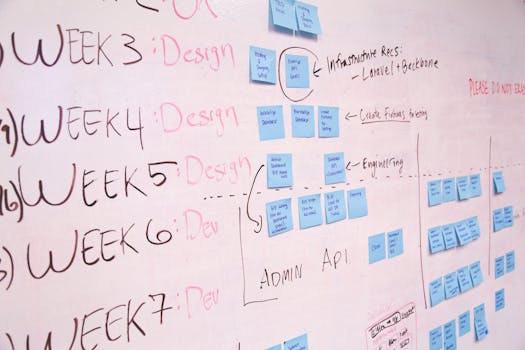Breaking Down Large Projects into Manageable Parts
In today's fast-paced world, managing large projects can often feel overwhelming. With numerous tasks, tight deadlines, and team dynamics at play, the challenge can escalate quickly. Breaking down large projects into manageable parts not only enhances productivity but also promotes clarity among team members. This method acts as a roadmap, ensuring everyone is aligned and working towards a common goal.
Understanding how to segment a project brings several advantages. It allows for easier tracking of progress, encourages teamwork, and drives motivation as teams celebrate small wins along the way. In this article, we will delve into effective strategies to deconstruct large projects into smaller, actionable parts.

📊 Key Concepts
When breaking down a project, it’s essential to understand some key concepts that will guide this process.
🎯 Project Decomposition
Project decomposition is the process of dividing a complex project into smaller, more manageable tasks. This structured approach helps clarify responsibilities and reduces the feeling of being overwhelmed. The key here lies in creating clear and concise tasks that can be executed independently by different team members or groups.
🔗 The Work Breakdown Structure (WBS)
WBS is a central concept in project management that outlines the total scope of a project in a hierarchical manner. It breaks the project into deliverables, then further breaks those down into individual tasks.
- Purpose: The WBS helps in organizing the team's work and forms the basis for task allocation.
- Example: For a website redesign project, the WBS may include sections like "Content Creation," "Design," "Development," and "Testing."
🗂️ SMART Goals
Setting SMART goals (Specific, Measurable, Achievable, Relevant, Time-bound) provides a framework for defining your tasks. Each goal should directly relate to the project objectives, ensuring that each sub-task contributes meaningfully to the larger project.
- Specific: What exactly needs to be accomplished?
- Measurable: How will success be measured?
- Achievable: Is the goal realistic?
- Relevant: Does it align with wider project objectives?
- Time-bound: What is the deadline?
🔄 Continuous Review
Breaking down projects is not a one-time activity but an ongoing process. Regularly reviewing progress allows teams to pivot when necessary. Implementing agility in project management means being flexible and responsive to changes should they arise.
🎯 How to Apply
Now that we've explored the key concepts, it’s time to dive into the practical side of breaking down large projects into manageable parts with actionable steps.
📌 Step 1: Define Project Scope
Define the scope of your project before any breakdown. This involves identifying the objectives and deliverables.
- Example: For a marketing campaign, the scope could include "increasing brand awareness" and "driving website traffic."
📂 Step 2: Create a Work Breakdown Structure (WBS)
Use the WBS method to visually outline the project components.
- Example: If you are organizing a conference, your WBS may look like this:
- 📅 Main Task: Organize Conference
- 📍 Sub-task: Select Venue
- 📍 Sub-task: Create Agenda
- 📍 Sub-task: Invite Speakers
- 📍 Sub-task: Promote Event
- 📅 Main Task: Organize Conference
📈 Step 3: Set SMART Goals
Once you have your WBS, it's time to formulate your goals using the SMART criteria.
- Example: For the task "Promote Event," a SMART goal could be: “Increase social media engagement by 20% over one month before the event.” By framing goals this way, each task has a clear target.
🎯 Step 4: Assign Responsibilities
Delegating tasks is key to ensuring accountability. Assign responsibilities based on team members' skills and interests.
- Example: If you have three team members:
- 💼 Team Member A: Focus on Venue Selection
- 💼 Team Member B: Handle Speaker Invitations
- 💼 Team Member C: Manage Promotions
📅 Step 5: Develop a Timeline
Creating a timeline outlines when each task should start and finish. Use tools like Gantt charts for a visual representation of your overall project timeline.
- Example: The timeline for the conference could be:
- Week 1: Venue selection
- Week 2: Send out speaker invitations
- Weeks 3-4: Start promoting the event
🔄 Step 6: Monitor Progress
Regularly check in with the team to assess progress on tasks. Use project management tools like Trello or Asana for tracking.
- Example: Schedule weekly meetings to discuss the status of each sub-task and to address any challenges.
📈 Step 7: Adapt and Reiterate
Projects rarely go according to plan. Be open to revising your approach based on feedback and results.
- Example: If promotional efforts fail to boost engagement as anticipated, revisit strategies and consider shifting resources towards paid ads.
Manage projects with Workfeed
Workfeed is the project management platform that helps small teams move faster and make more progress than they ever thought possible.
Get Started - It's FREE* No credit card required
🛠️ Frequently Asked Questions
Here are some frequently asked questions about "Breaking Down Large Projects into Manageable Parts."
🎉 Conclusion
Breaking down large projects into manageable parts is a proven strategy to improve efficiency, collaboration, and success rates in project management. By employing a structured approach like project decomposition, utilizing a Work Breakdown Structure, setting SMART goals, and regularly reviewing progress, you empower your team to tackle projects effectively. Remember, the path to successful project completion involves not just careful planning, but also adaptability and open communication. So, take that first step, break it down, and watch your projects flourish! 🌟